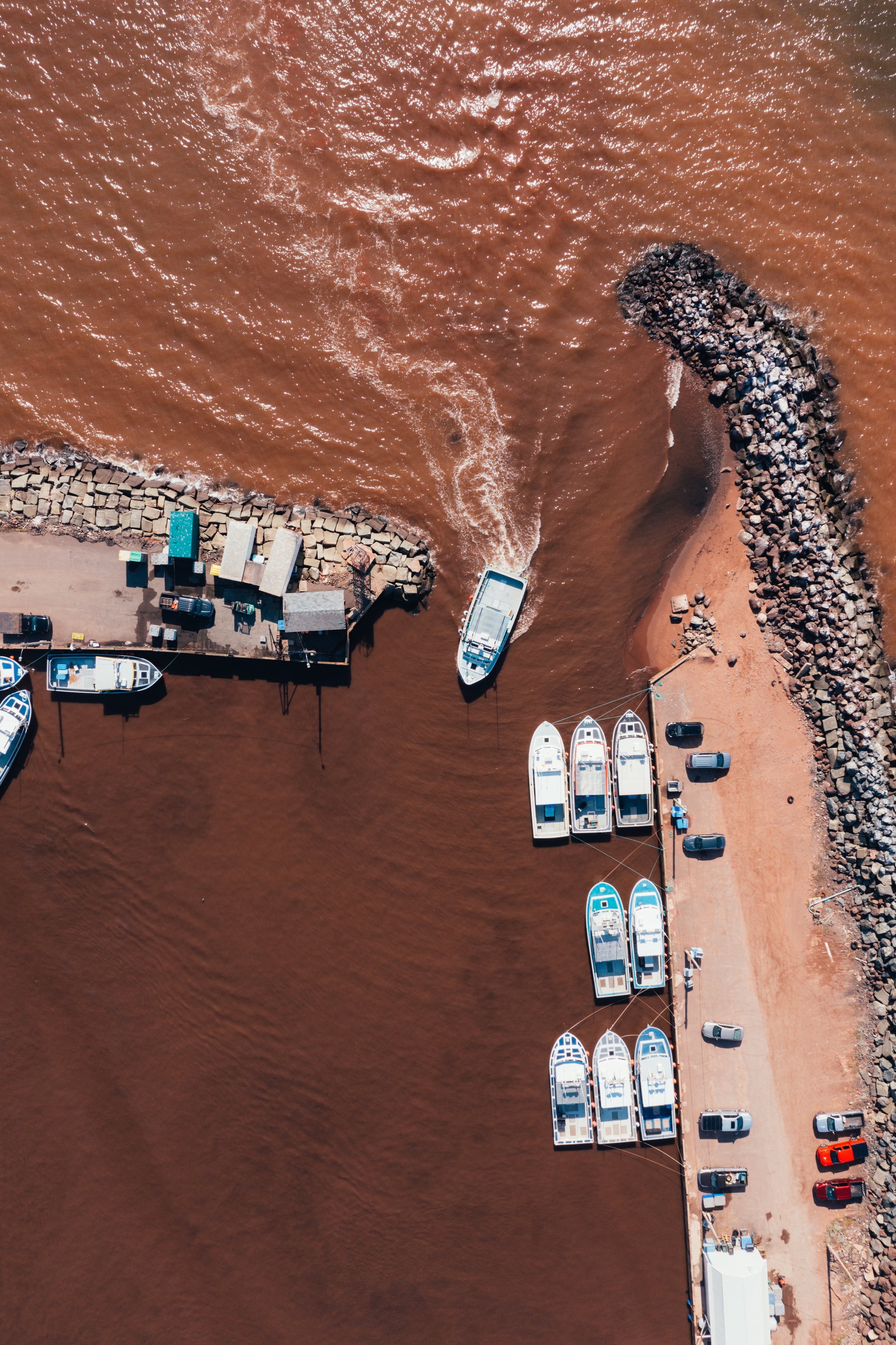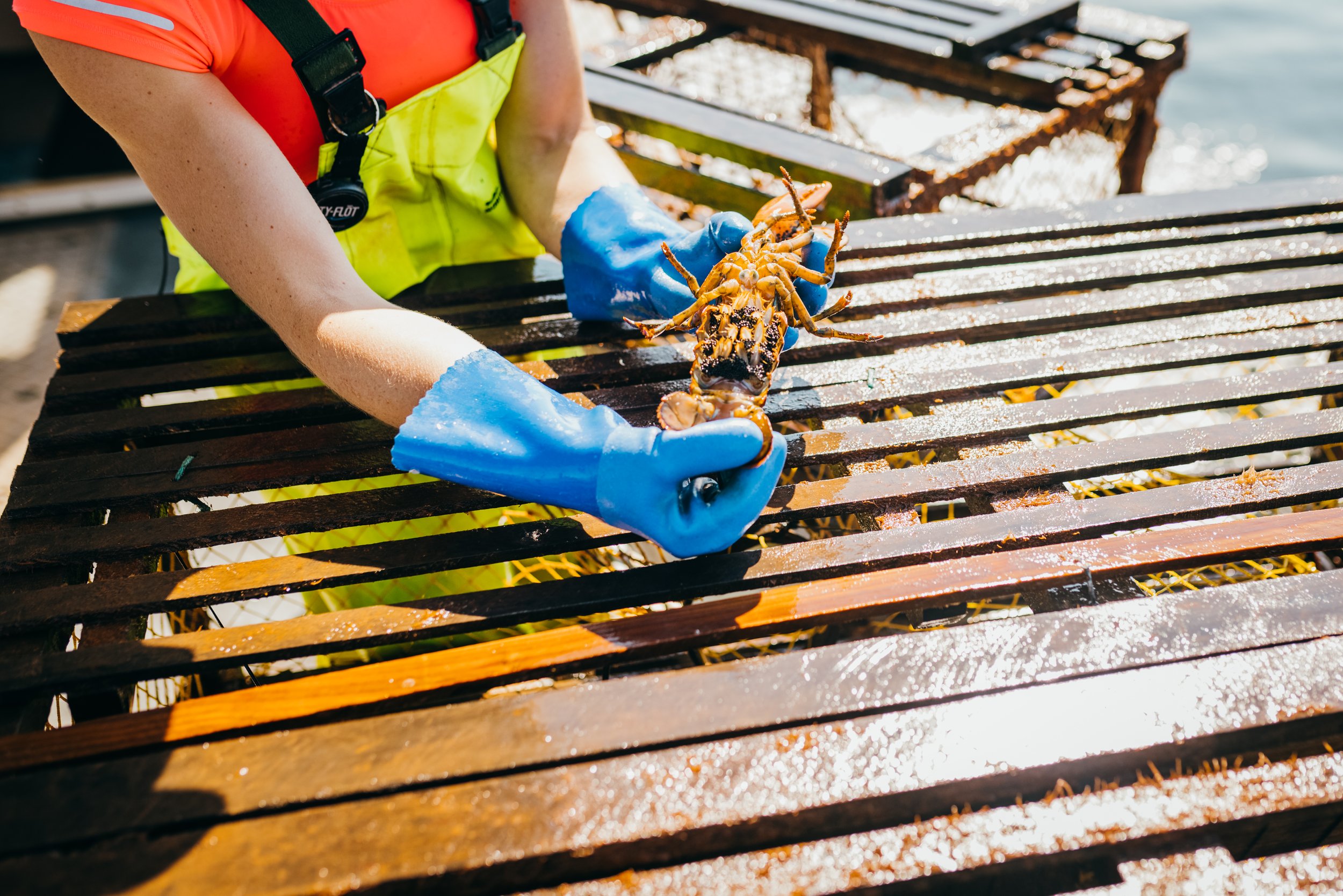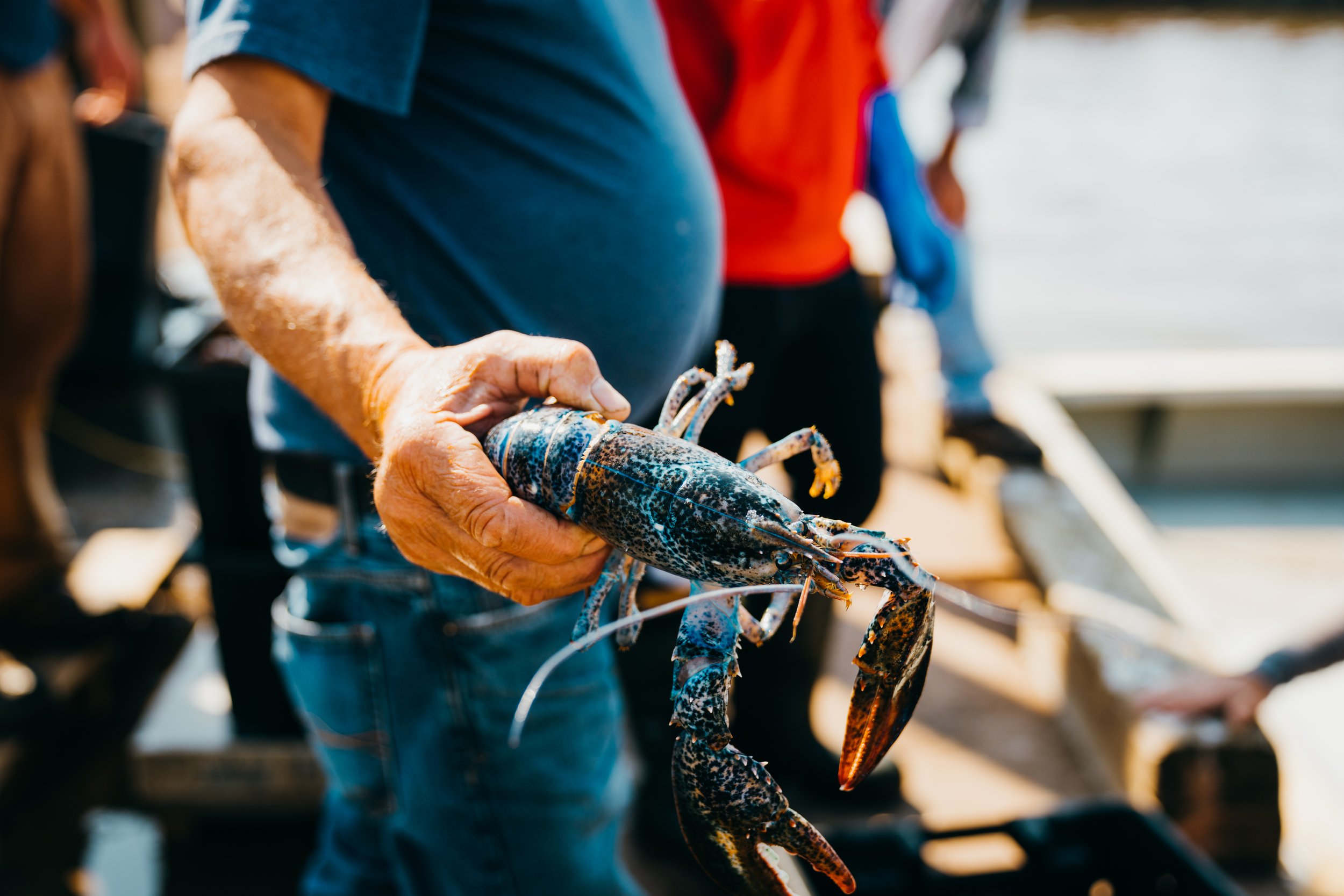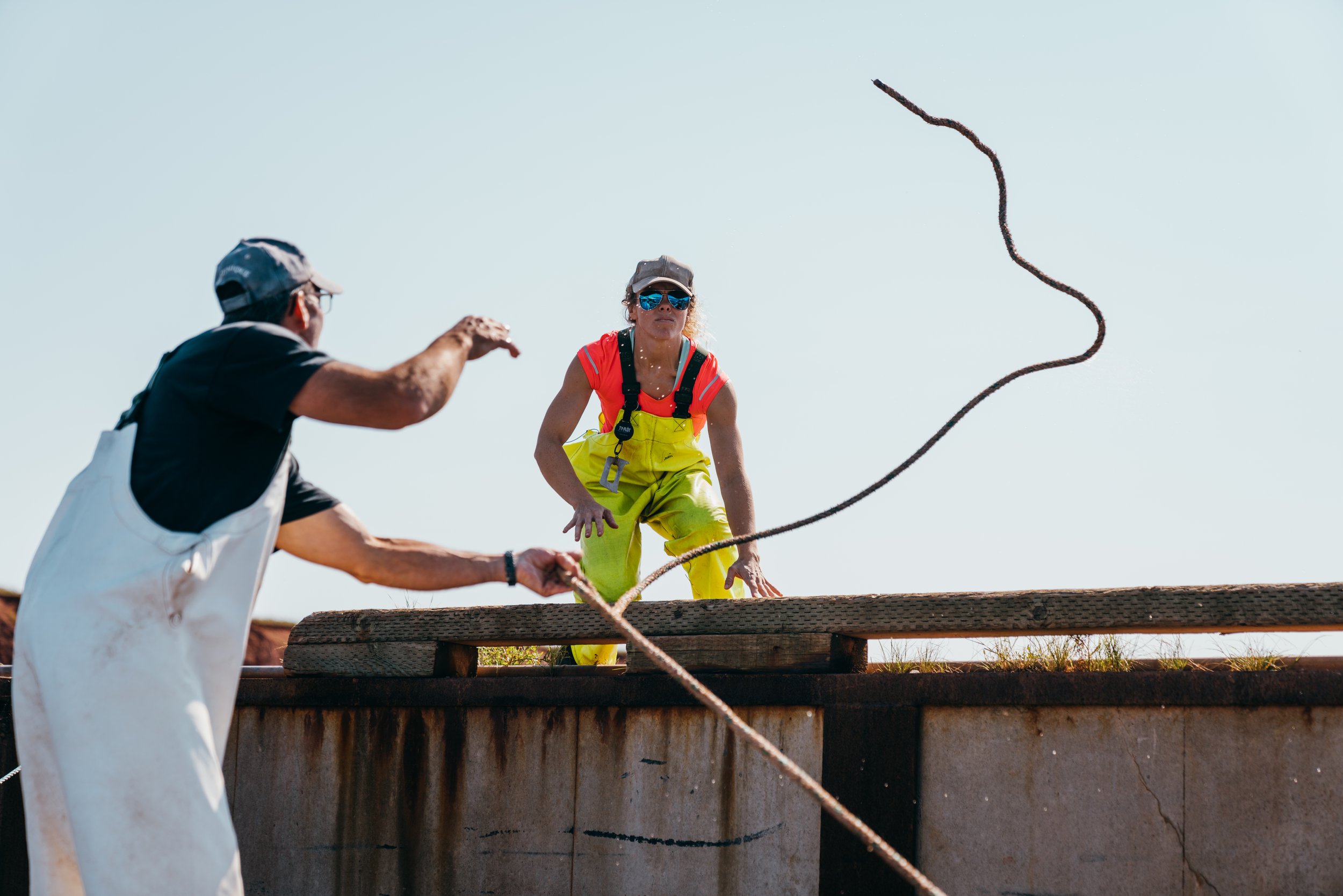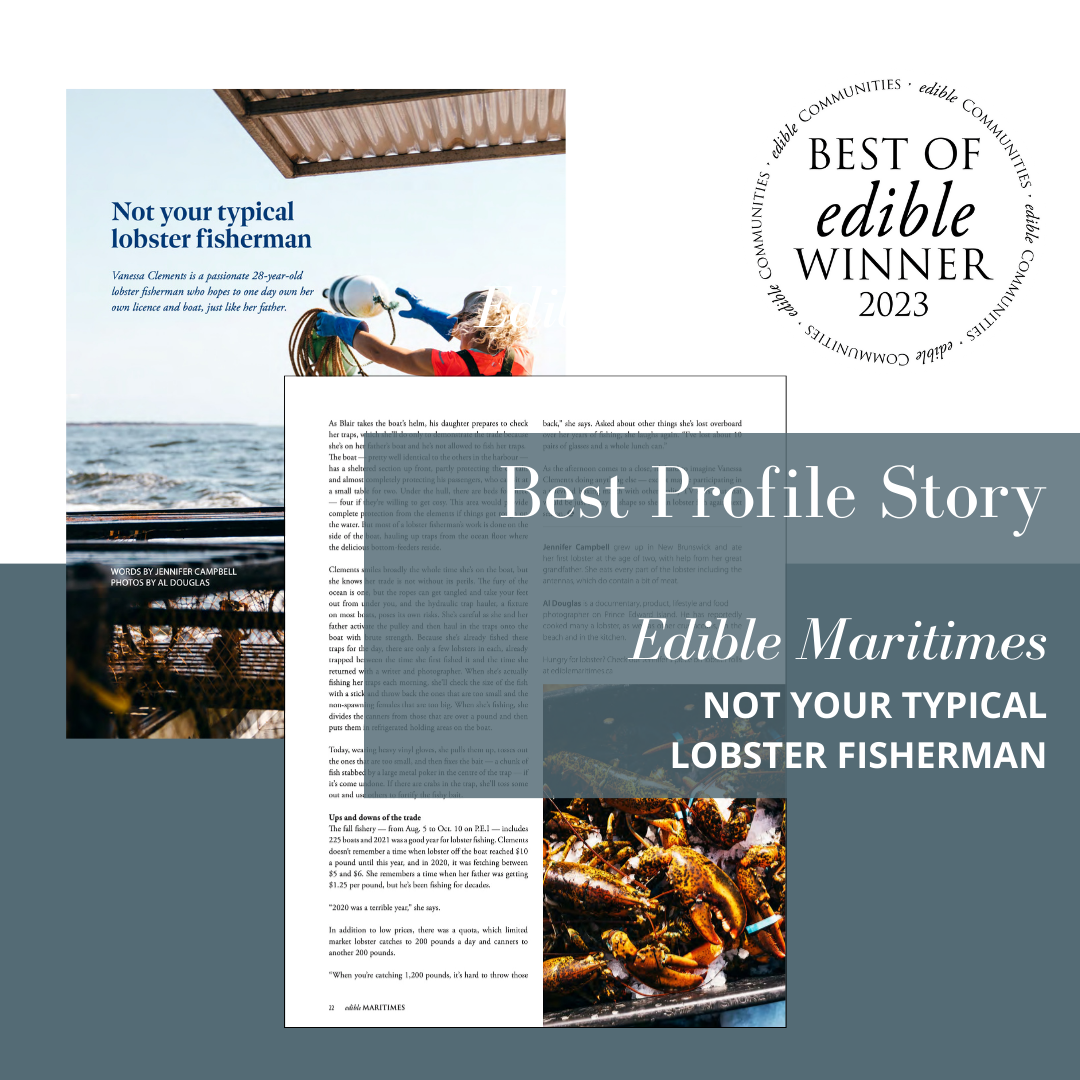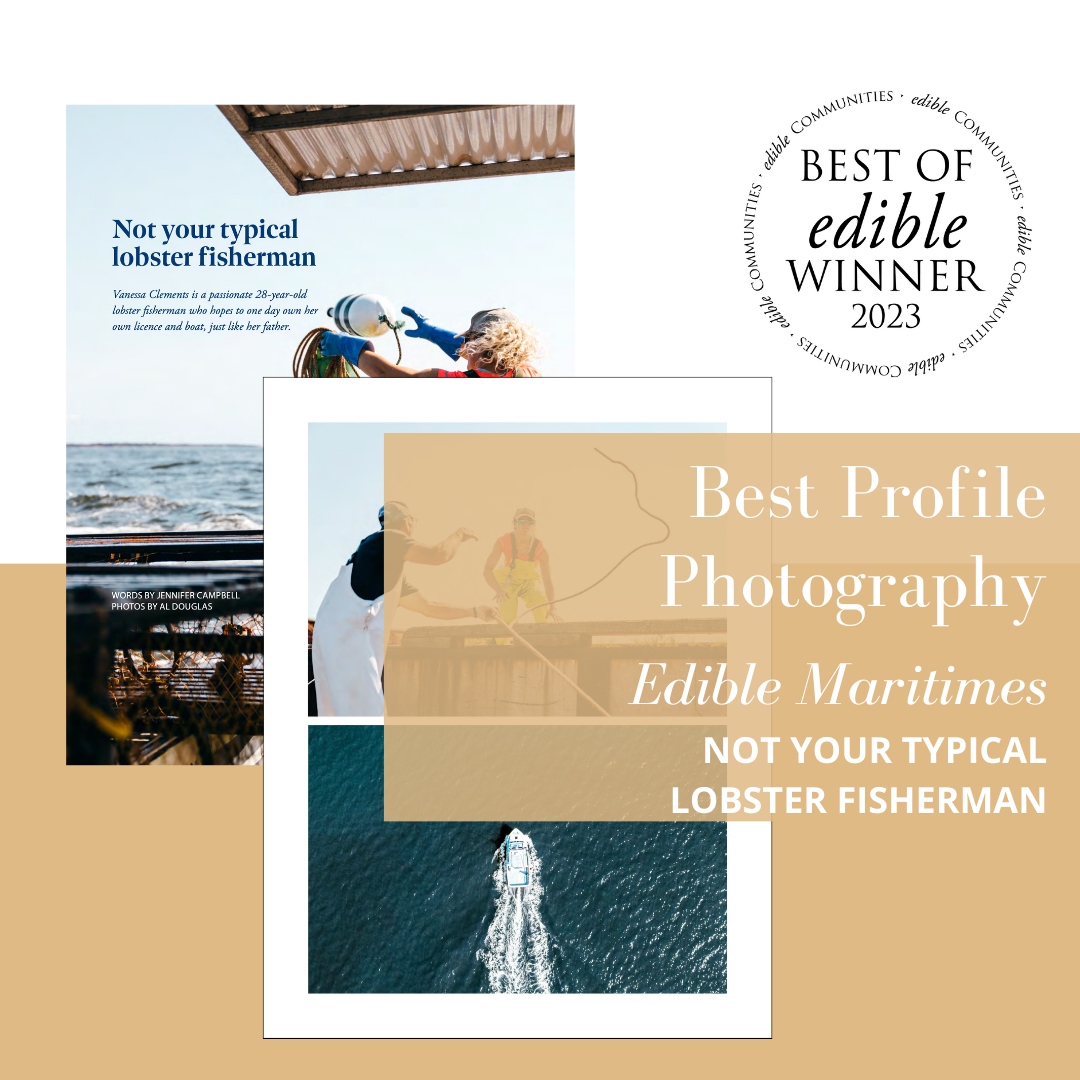Words by Jennifer Campbell ~ Photos by Al Douglas
Not your typical fisherman
Vanessa Clements is a passionate 28-year-old lobster fisherman who hopes to one day own her own licence and boat, just like her father.
Vanessa Clements looks like an Olympic gymnast, bouncing from her fishing boat several feet up onto the wharf and back down again. It’s 1 p.m. and Clements has been awake since 3:15 a.m., when she climbed out of bed and had breakfast before donning a bright pink T-shirt and fluorescent green hip-wader suspenders — held together at the back with a small bungee cord so they actually fit her tiny torso. She then packed her lunch in a hand-held cooler and left her Mill River home to get to Howard’s Cove wharf — a 10-minute drive — to board the Native Council’s lobster fishing boat on which she serves as the “second man” of three and assistant to the “first man” or captain.
Now, nearly 10 hours after her alarm went off, and after having checked, fished and delivered the delicious red yields from 250 traps, Clements bounds out of the boat on sheer adrenaline. The vessel is set deep within the harbour and requires a leap to get up on the wharf. She grabs one of two heavy ropes that will secure the Hannah Grace in place and then she’s back in the boat, heaving 85-pound bins of lobster onto the side of the boat and then helping the “third man” heft them up to the waiting arms of wholesalers who will escort them off to those who will sell them. Much of it will go to a plant and be sold as tails and claws, some will go to restaurants and retailers and still more will go offshore to well-heeled foreigners who know the east coast of Canada has the best sea creatures in the world.
An afternoon jaunt
After spending the morning checking her 83 groupings of three traps (and one with four), connected to a pair of buoys — one green and one striped black and white, the colours serving to indicate who owns them —she’s back at shore to take a curious reporter and photographer out on the water to show them what it takes to put lobster on our plates.
Normally, her day would be ending, so does she mind going back out? Her large smile, complete with deep dimples, says no.
“I just love lobster fishing so much,” Clements says, moving blithely around the boat like a cat who always lands on her feet while her landlubbing visitors are tentative on the slippery floors of the fast-moving vessel.
Her father, Blair Clements, has also been on the water for nine hours and yet, after clearing the creatures off his boat — B.C.’s Place — he’s also happy to go back out. Lobster fishing courses through their veins. Blair’s father, Cecile, bought his first licence for 50 cents in 1960. It eventually went to his son, Tony — Vanessa’s uncle — and was then sold outside the family. Vanessa hopes to one day purchase her dad’s licence, which she estimates is worth $1.5 million between the licence, the boat and the gear.
“I’m saving my money,” the spunky 28-year-old says with another smile.
Blair, 57, fishes on B.C.’s Place with his wife, Cindy, and their 30-year-old son, Ryan, and the father-daughter duo are using that boat for the afternoon jaunt.
Vanessa, who is allowed to work on the P.E.I. Native Council’s boat because she is Indigenous through her father’s side, fishes both seasons on P.E.I. Between late April and June, she fishes the south and east end of the island while in August and September, she fishes closer to home, off the northwestern tip.
Above top: Fishing boat coming into Howard's Cove wharf.
Above: Vanessa Clements assesses lobster size
Hard seasonal work
Her day starts early as part of a tradition that allows fishermen and women to get back in time to meet the buyers on the wharf and allow them to get the red sea bugs as quickly as possible from the boat to their next destination, whether to a processing plant or to the plates of curious tourists who show up on the wharf to buy direct from those who fish them.
Asked how she developed the muscles to be able to heft the “pans” — large plastic bins, brimming with lobster weighing 85 pounds each — around the boat at the end of a long day, she said she just kept working at it.
“I’ve never been to a gym a day in my life,” she says. “When I first started fishing as a career, I was struggling. I worked my ass off to develop the strength to do the job.”
Clements is convinced she actually has to work harder because she’s a woman. “I never want my crew to think we’ll be less efficient because of me,” she says. “I hope at some point, there’s a day when it’s normal to have women lobster fishermen.”
For her part, she had a very immediate female role model — her mom, Cindy.
“My mom fished until she was eight months pregnant,” Clements says. After that revelation, it seems surprising Clements isn’t at least part mermaid.
Now that she’s strong enough to do the job and heft the lobster easily as well as pulling up 150-pound traps from depths of 115 feet, Clements makes a point of staying active in the off season so she doesn’t lose her strength. This past winter, for example, she trained for a televised boxing match between reality TV stars.
A few years back, she applied and was accepted onto Big Brother Canada, which was in mid-production in March 2020 when COVID hit and the lockdowns forced the show to stop filming almost immediately. It was her contacts with Big Brother who asked her to participate in the boxing match.
Clements thinks the novelty of being a female lobster fisherman — the latter masculine term is how she refers to herself — was what made her application to Big Brother compelling and what ultimately gave her the distinction of being the first Prince Edward Islander to be on the show.
“I think it was a big reason,” she says with a laugh. “They always wanted me to wear my oil gear [also known as her lobster-fishing wader/suspenders.] I grew up on a dirt road — for me to get that opportunity was amazing. There are people I’ll always been in touch with from that show.”
Above: Lobster just off the boat will go to wholesalers, restaurants and retailers.
Right top: Blair Clements tosses his daughter the line as they dock their boat.
Out on the water
It can be cold in the Gulf of St. Lawrence in September, but on this afternoon, the sun is shining and the wind is almost non-existent. Clements has warned her passengers to wear rubber boots on board as feet can get wet between the water laden traps being brought on board, and the water washing up on the back of the trawler.
As Blair takes the boat’s helm, his daughter prepares to check her traps, which she’ll do only to demonstrate the trade because she’s on her father’s boat and he’s not allowed to fish her traps.
The boat — pretty well identical to the others in the harbour — has a sheltered section up front, partly protecting the captain and almost completely protecting his passengers, who can sit at a small table for two. Under the hull, there are beds for three — four if they’re willing to get cosy. This area would provide complete protection from the elements if things got rough on the water. But most of a lobster fisherman’s work is done on the side of the boat, hauling up traps from the ocean floor where the delicious bottom-feeders reside.
Clements smiles broadly the whole time she’s on the boat, but she knows her trade is not without its perils. The fury of the ocean is one, but the ropes can get tangled and take your feet out from under you, and the hydraulic trap hauler, a fixture on most boats, poses its own risks. She’s careful as she and her father activate the pulley and then haul in the traps onto the boat with brute strength. Because she’s already fished these traps for the day, there are only a few lobsters in each, already trapped between the time she first fished it and the time she returned with a writer and photographer. When she’s actually fishing her traps each morning, she’ll check the size of the fish with a stick and throw back the ones that are too small and the non-spawning females that are too big. When she’s fishing, she divides the canners from those that are over a pound and then puts them in refrigerated holding areas on the boat.
Today, wearing heavy vinyl gloves, she pulls them up, tosses out the ones that are too small, and then fixes the bait — a chunk of fish stabbed by a large metal poker in the centre of the trap — if it’s come undone. If there are crabs in the trap, she’ll toss some out and use others to fortify the fishy bait.
Ups and downs of the trade
The fall fishery — from Aug. 5 to Oct. 10 on P.E.I — includes 225 boats and 2021 was a good year for lobster fishing. Clements doesn’t remember a time when lobster off the boat reached $10 a pound until this year, and in 2020, it was fetching between $5 and $6. She remembers a time when her father was getting $1.25 per pound, but he’s been fishing for decades.
“2020 was a terrible year,” she says.
In addition to low prices, there was a quota, which limited market lobster catches to 200 pounds a day and canners to another 200 pounds.
“When you’re catching 1,200 pounds, it’s hard to throw those back,” she says. Asked about other things she’s lost overboard over her years of fishing, she laughs again. “I’ve lost about 10 pairs of glasses and a whole lunch can.”
As the afternoon comes to a close, it’s hard to imagine Vanessa Clements doing anything else — except maybe participating in a televised boxing match with other reality TV stars. But that would be just to stay in shape so she can lobster fish again next season. 🦞
Right bottom: Fishing boat heading out to check the traps.
Jennifer Campbell grew up in New Brunswick and ate her first lobster at the age of two, with help from her great grandfather. She eats every part of the lobster including the antennas, which do contain a bit of meat.
Al Douglas is a documentary, product, lifestyle and food photographer on Prince Edward Island. He has reportedly cooked many a lobster, as well as other crustaceans, on the beach and in the kitchen.




